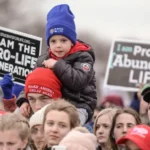
Published January 23, 2023
Last week’s rejection by Florida governor Ron DeSantis of the College Board’s pilot AP African-American Studies (APAAS) course has kicked up a controversy. Last Friday, White House press secretary Karine Jean-Pierre falsely accused DeSantis of trying to “block . . . the study of black Americans.” In reality, DeSantis barred only this specific and very biased APAAS course plan — while inviting the College Board to revise it. Florida’s Stop WOKE Act actually mandates the teaching of a series of topics in the history of black Americans, from slavery, racial oppression, racial segregation, and racial discrimination, to the overcoming of these injustices, and more. So there is no question here of “blocking the study of black Americans.” The issue is what specific sort of curriculum a given state should favor.
The debate over APAAS has been complicated by the College Board’s secrecy. The College Board has steadfastly refused to release the APAAS curriculum framework or associated materials. Nonetheless, I obtained a copy of the APAAS curriculum and wrote about it in September, laying out its socialist agenda and its promotion of Critical Race Theory (CRT). Unfortunately, no one could judge the accuracy of my characterization because the curriculum remained secret. I confined myself at the time to a “fair use” discussion of the framework, declining to publish the full curriculum out of respect for the College Board’s insistence that it was a “trade secret.” In the wake of the controversy, however, the Florida Standard newspaper has obtained a copy of the pilot APAAS curriculum and made it public.
In another new development, I have now obtained a copy of a second document, the “APAAS Pilot Course Guide,” a manual designed for use by teachers. Taken together, the curriculum framework and the teacher’s guide expand our understanding of the course in a way that confirms the wisdom of DeSantis’s decision.
The most serious problems in APAAS are in the final quarter of the class (“Unit 4: Movements and Debates”). This is where the course grapples with contemporary political and cultural controversies. Overwhelmingly, APAAS’s approach is from the socialist Left, with very little in the way of even conventional liberal perspectives represented, not to mention conservative views. Most of the topics in the final quarter present controversial leftist authors as if their views were authoritative, with no critical or contrasting perspectives supplied. The scarcely disguised goal is to recruit students to various leftist political causes. Now let’s get down to cases.
The fourth quarter of the course features a topic on “The Movement for Black Lives.” The Movement for Black Lives (M4BL) was started by the Marxist organizers who founded Black Lives Matter. Yet M4BL extends far beyond BLM, encompassing “over 170 Black-led organizations.” M4BL is organized around an extensive policy platform, the “Vision for Black Lives.” That platform is radical, to say the least. As you might expect, it includes planks such as defunding the police. M4BL’s platform goes further, however, by calling for the abolition of all money bail, and even all pretrial detention. To this end, the “Vision for Black Lives” endorses federal legislation by “Squad” member, Representative Ayanna Pressley.
It would be a mistake, however, to think of M4BL’s extensive policy menu as a mere attempt to influence the platform of the Democratic Party. As explained by Marxist activist Robin D. G. Kelley (whose work is the subject of the very next APAAS topic), the real purpose of M4BL’s platform is to serve as a “blueprint for social transformation,” radically changing the structure of American society by shifting us away from market principles and toward “’collective ownership’ of certain economic institutions” and a universal basic income.
Kelley also highlights the expansive nature of what he calls M4BL’s most controversial demand: reparations. For M4BL, the concept of reparations goes far beyond massive monetary awards and includes even “mandated changes in the school curriculum that acknowledge the impact of slavery, colonialism, and Jim Crow in producing wealth and racial inequality.” According to Kelley, M4BL wants these changes so schools can undermine “the common narrative that American wealth is the product of individual hard work and initiative, while poverty results from misfortune, culture, bad behavior, or inadequate education.” In other words, M4BL (and Kelley) want schools to inculcate the basic premises of Critical Race Theory.
The APAAS teacher’s guide presents M4BL’s agenda in a way that is entirely free of criticism or alternative viewpoints. All the recommended topic readings support Black Lives Matter, and the “possible focus areas” provided for teachers uncritically summarize M4BL’s policy platform.
One of two recommended books for this topic is From #BlackLivesMatter to Black Liberation, by Keeanga-Yamahtta Taylor. Taylor is a socialist, and in no way shy about it. Her book argues that BLM is a step toward what ought to be a revolutionary socialist transformation of the United States. While Taylor rejects Stalin’s authoritarianism, she remains quite fond of Marx and Lenin. Taylor sees capitalism as synonymous with racism, and she argues that any successful struggle against racism must ultimately replace capitalism as well. Taylor also dismisses “colorblindness” as a ploy to disguise the racism inherent in the capitalist system. (This view of colorblindness is excluded from Florida’s curriculum by law.)
Far from BLM fulfilling American ideals, as Taylor sees it, “when the Black movement goes into motion, it destabilizes all political life in the United States,” exposing “the foundational lie of the United States as a free and democratic society.” Taylor ends her book with a quote from the Marxist intellectual and “revolutionary,” C. L. R. James: “The hatred of bourgeois society and the readiness to destroy it when the opportunity should present itself, rests among [Blacks] to a degree greater than in any other section of the population in the United States.”
Virtually all APAAS authors in the final quarter of the course are part of the same tight group of far-left activists. Taylor’s book carries an enthusiastic blurb from Barbara Ransby, the author of the other book assigned for this topic; another blurb from Robin D. G. Kelley, the Marxist radical whose work is the subject of the very next APAAS topic; and a blurb from Michelle Alexander, whose work is the subject of a previous APAAS topic. In general, readings by authors assigned in the final quarter of APAAS endorse, are endorsed by, and overlap with, other APAAS readings. When it comes to APAAS’s treatment of contemporary policy debates, conventional American liberals and conservatives need not apply.
The APAAS topic immediately prior to the topic on “The Movement for Black Lives” covers “The Reparations Movement.” We’ve just seen that the most controversial demand of M4BL is reparations, expansively defined to include even mandated school curricula. So why does APAAS include yet another topic on reparations? It may not add up as an educational strategy, but it is an effective political recruiting tool.
The three suggested items for study in the reparations topic are Ta-Nehisi Coates’s article “The Case for Reparations,” a button that the teacher’s guide says serves to “promote” reparations for the Tulsa race massacre, and the copy of H.R. 40, a federal bill that sets up a commission to develop proposals for reparations. It’s clear from these assignments that APAAS itself is promoting reparations. No article criticizing this highly controversial policy is assigned. In effect, APAAS is pushing students to lobby for legislation. And by the way, M4BL also endorses H.R. 40, so students will find the same de facto call to legislative lobbying waiting for them in two successive topics.
The teacher’s guide purports to outline “debates” over reparations, yet the so-called debates don’t actually involve arguments against reparations. By “debates,” the guide simply means practical disagreements about who exactly should pay for reparations, who exactly should benefit, and the precise mixture of monetary compensation and public apology to be demanded. There is no disagreement about reparations as such. This is political advocacy, pure and simple.
The topics on reparations and M4BL are part of a special section of the course. That section presents four different topics touching on “Contemporary Issues and Debates.” This special set of four optional topics allows teachers to instruct students to focus in-depth on only one of the topics in question. The selection of a single topic out of the four options can be done by a whole class, by small groups of students, or by each individual student. In addition to reparations and M4BL, students can focus either on “Incarceration, Abolition, and the New Jim Crow,” or on injustices and activism regarding “Medicine, Technology, and the Environment.” Because students choose only one of the four topics to explore in-depth, all four topics are omitted from the final AP Exam. Students, the guide says, cannot be held responsible on the test for the topics they didn’t choose to focus on.
So far as I know, this omission of four topics from the exam is an unusual arrangement. By omitting a great deal of material from exam coverage, the College Board appears to be making the APAAS exam significantly easier than it might have been. (Some teachers will be able to fit the non-tested topic in after the test, but others will teach it earlier in the year, prior to the test.) That’s important, because AP exams are supposed to reveal a student’s capacity to handle college-level demands. The omission of content from the exam also allows APAAS to include much more material on contemporary activism, precisely because students will not have to be tested on that material. Finally, the omission of course material from the exam allows students to focus in-depth on a single chosen political cause in a way that makes a great deal of sense if your real goal is to recruit students into leftist activism.
It would be a mistake, however, to conclude that the topics most obviously oriented to contemporary political activism are somehow separated from the rest of the course. On the contrary, consistent political themes run through the entire final quarter of APAAS.
In my initial piece on APAAS, I pointed to indications that the course would focus on revolutionary violence as advocated in the work of Franz Fanon, and especially on the reception of Fanon’s writings by American radicals such as Malcolm X and the Black Panther Party. The teacher’s guide confirms this. The guide stresses Fanon’s interest in anti-colonial violence. It then connects Fanon’s work to the belief by black radicals in the 1960s and 1970s that African Americans in the United States live in a kind of “internal colony,” thereby justifying violence here in America. The teacher’s guide also emphasizes the Black Power movement’s critique of nonviolent civil-rights activists. Here’s a quote from the guide on that issue: “Black Power advocates leveraged Fanon’s notion of the ‘colonized intellectual’ to critique the respectability politics of some middle-class, nonviolent activists as assimilationist.” In contrast, I saw little or no critique of violent radicals by more moderate voices, in either the APAAS curriculum or in the teacher’s guide.
The APAAS teacher’s guide touches again on Fanon’s theory of liberating violence in the topic of “The Black Power Movement” and in the topic of “The Black Panther Party for Self-Defense” (another repetitive pairing of topics on overlapping radical themes). If you actually dive into the readings at the end of the course, you see how deeply APAAS brings this theme of violence into the present.
Keeanga-Yamahtta Taylor’s assigned book on BLM, for example, invokes the ’60s Black Power Movement’s understanding of American blacks as “colonial subjects in relation to white society” (heavily based on a reading of Fanon). In effect, Taylor uses this analogy to justify her contemporary revolutionary message. That exhortatory passage on blacks’ “readiness to destroy bourgeois society” by C. L. R. James, with which Taylor concludes her book, for example, also includes this: “Let us not forget that in the Negro people, there sleep and are now awakening passions of a violence exceeding, perhaps, as far as these things can be compared, anything among the tremendous forces that capitalism has created.”
The teacher’s guide also confirms what I claimed in my initial piece: that the course will assign Robin D. G. Kelley’s essay “Black Study, Black Struggle,” a Marx-inspired argument on the revolutionary purposes to which black-studies courses ought to be put. Kelley maintains that the real goals of black studies can be fulfilled only by radical study and activism outside the academy. Kelly wants students to return to the days of the ’60s radicals who demanded the creation of black-studies courses while also carrying their commitment to the “overthrow of capitalism” far beyond mere coursework. The teacher’s guide not only identifies these themes in the topic on Kelley’s work; it also ties Kelley’s work to the demands of “The Movement for Black Lives,” the immediately preceding topic within APAAS. And as we’ve seen, Kelley is a prominent advocate for M4BL.
In short, as I argued last September, the final quarter of APAAS conveys and promotes a story of leftist political radicalism as a model for student activism. That radicalism is grounded in Marxist socialism, is far from averse to violence, and is consistent with the core assumptions of CRT. Virtually no conventional liberal or conservative voices emerge in the final quarter of the course to contradict this narrative. So the additional information provided by the still-secret APAAS teacher’s guide, a copy of which I have now obtained, confirms what we already knew. DeSantis was right to block this course. Indoctrination in socialism and CRT have no place in Florida schools. Both are rightly prohibited by law and policy.
And now, with new evidence confirming the radicalism of APAAS, what will other governors say and do?
Stanley Kurtz is a Senior Fellow at the Ethics and Public Policy Center. Beyond his work with Education and American Ideals, Mr. Kurtz is a key contributor to American public debates on a wide range of issues from K-12 and higher education reform, to the challenges of democratization abroad, to urban-suburban policies, to the shaping of the American left’s agenda. Mr. Kurtz has written on these and other issues for various journals, particularly National Review Online (where he is a contributing editor).
Photo by Scott Webb on Unsplash
Stanley Kurtz is a Senior Fellow at the Ethics and Public Policy Center. Beyond his work with Education and American Ideals, Mr. Kurtz is a key contributor to American public debates on a wide range of issues from K–12 and higher education reform, to the challenges of democratization abroad, to urban-suburban policies, to the shaping of the American left’s agenda. Mr. Kurtz has written on these and other issues for various journals, particularly National Review Online (where he is a contributing editor).












